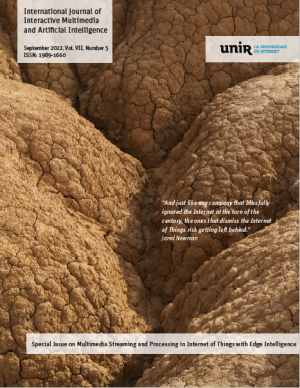Improvement in Quality of Service Against Doppelganger Attacks for Connected Network.
DOI:
https://doi.org/10.9781/ijimai.2022.08.003Keywords:
Controller, Doppelganger, Remote Configuration, Security, Transportation, Internet of thingsAbstract
Because they are in a high-risk location, remote sensors are vulnerable to malicious ambushes. A doppelganger attack, in which a malicious hub impersonates a legitimate network junction and then attempts to take control of the entire network, is one of the deadliest types of ambushes. Because remote sensor networks are portable, hub doppelganger ambushes are particularly ineffective in astute wellness contexts. Keeping the framework safe from hostile hubs is critical because the information in intelligent health frameworks is so sensitive. This paper developed a new Steering Convention for Vitality Effective Systems (SC-VFS) technique for detecting doppelganger attacks in IoT-based intelligent health applications such as a green corridor for transplant pushback. This method's main advantage is that it improves vitality proficiency, a critical constraint in WSN frameworks. To emphasize the suggested scheme's execution, latency, remaining vitality, throughput, vitality effectiveness, and blunder rate are all used. To see how proper the underutilized technique is compared to the existing Half Breed Multi-Level Clustering (HMLC) computation. The suggested approach yields latency of 0.63ms and 0.6ms, respectively, when using dead hubs and keeping a strategic distance from doppelganger assault. Furthermore, during the 2500 cycles, the suggested system achieves the highest remaining vitality of 49.5J.
Downloads
References
E.F.A. Elsmany, M.A. Omar, T.C. Wan, A.A. Altahir, EESRA: energy efficient scalable routing algorithm for wireless sensor networks, IEEE-Institute of Electrical and Electronics Engineers Access 7 96974–96983, 2019.
W. Zhang, D. Han, K. C. Li and F. I. Massetto, “Wireless sensor network intrusion detection system based on MK-ELM,” Soft Computing, vol. 24, no. 16, pp. 12361–12374, 2020.
M. Adil, M. A. Almaiah, A. O. Alsayed, and O. Almomani, “An anonymous channel categorization scheme of edge junctions to detect jamming attacks in wireless sensor networks,” Sensors (Switzerland), vol. 20, no. 8, pp. 1–19, 2020.
J. John, P. Rodrigues, "Multi-objective HSDE Algorithm for Energy-Aware Group controller Selection in WSN,” Journal of Networking and Communnication Systems, vol. 2, no. 3, pp. 20–29, 2019.
S. Aljawarneh, M. Aldwairi, M.B. Yassein, “Anomaly-based intrusion detection system through feature selection analysis and building hybrid efficient model,” Journal of Computer Science, vol. 25, pp. 152–160, 2018.
N. T. Tam, T. Q. Tuan, H. T. T. Binh, A. Swami, “Multifactorial evolutionary optimization for maximizing data aggregation tree lifetime in wireless sensor networks,” in Artificial Intelligence and Machine Learning for Multi-Domain Operations Applications, volume-II, pp.114-130. 2020.
M. Safaldin, M. Otair and L. Abualigah, “Improved binary gray wolf optimizer and SVM for intrusion detection system in wireless sensor networks,” Journal of Ambient Intelligent and Humanized Computing, vol. 12, no. 2, pp. 1559–1576, 2021.
A. Mazinani, S.M. Mazinani, M. Mirzaie, "FMCR-CT: an energy-efficient fuzzy multi cluster based routing with a constant threshold in wireless sensor network,” Alexgdenra Engeerring Journal, vol. 58, pp. 127–141, 2019.
Z. Wang, C. Zhou, Y. Liu, “Efficient Hybrid Detection of Junction Replication Attacks in Mobile Sensor Networks,” Mobile Information Systems, pp. 1-13, 2017.
I. Qasemzadeh Kolagar, H. Haj Seyyed Javadi, M. Anzani, “Hypercube bivariatebased key management for wireless sensor networks,” Journal of Science of Networking, vol. 28, no. 3, pp. 273-285, 2017.
Q. Yu, L. Jibin, L. Jiang, “An improved ARIMA-based traffic anomaly detection algorithm for wireless sensor networks,” International Journal of Distributed Sensor Networks, vol. 12, no. 1, 2016.
D. Tian et al, “A microbial inspired routing protocol for VANETs,’’ IEEE Journal of Internet Things, vol. 5, no. 4, pp. 2293-2303, 2018.
K. Stepien, A.P. Poniszewska-Maranda, “Security Measures in Vehicular Ad-Hoc Networks on the Example of Bogus and Sybil Attacks,” Advanced Information Networking and Applications, vol. 1151, Springer, Cham. pp. 419–430, 2020.
R. Fotohi and S. Firoozi Bari, “A novel countermeasure technique to protect WSN against denial-of-sleep attacks using firefly and Hopfield neural network (HNN) algorithms,” Journal of Supercomputing, vol. 76, no. 9, pp. 6860–6886, 2020.
M. Numan, “A Systematic Review on Doppelganger Junction Detection in Static Wireless Sensor Networks,” IEEE Access, vol. 8, pp. 65450–65461, 2020.
C. Hongsong, M. Caixia, F. Zhongchuan and C. H. Lee, “Novel LDoS attack detection by spark-assisted correlation analysis approach in wireless sensor network,” IET Information Security, vol. 14, no. 4, pp. 452–458, 2020.
J. Cui, L. Wei, J. Zhang, et al., “An efficient message-authentication scheme based on edge computing for vehicular ad hoc networks,” IEEE Transction. on Intelligent Transportation Systems, 1–12, 2018.
A. Boualouache, S. Senouci, and S. Moussaoui, “A Survey on Pseudonym Changing Strategies for Vehicular Ad-Hoc Networks,” IEEE Communications Surveys & Tutorials, vol. 20, no. 1, pp. 770–790, 2018.
R. W. van der Heijden, S. Dietzel, T. Leinmüller and F. Kargl, "Survey on Misbehavior Detection in Cooperative Intelligent Transportation Systems," in IEEE Communications Surveys & Tutorials, vol. 21, no. 1, pp. 779-811, Firstquarter 2019, doi: 10.1109/COMST.2018.2873088.
M. Ikeda, L. Barolli, "Performance of optimized link state routing protocol for video streaming application in vehicular ad-hoc networks cloud computing,” Concurrency and Computation Practice and Experience, vol. 27, no. 8, pp. 2054–2063, 2015.
Downloads
Published
-
Abstract257
-
PDF86









